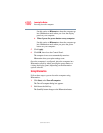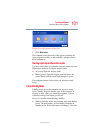
99
Learning the Basics
Powering down the computer
5.375 x 8.375 ver 2.3
to the hard disk. Since Hibernation mode does not require
power to maintain the saved information, the system settings
are retained indefinitely. Restoring information from the hard
disk takes longer than restoring it from memory. When you
start up again, the computer runs a self-test, loads the
operating system, and then returns to the state in which you
left it.
Factors when choosing Hibernation mode:
❖ While in Hibernation mode, the computer uses no battery
power.
❖ Because the state of the system is held on the hard disk,
no data is lost if the main battery discharges.
❖ Restarting from Hibernation mode uses less time and
battery power than restarting from Turn Off.
❖ Restarting from Hibernation mode uses a little more time
and battery power than restarting from Standby because
information is being retrieved from the hard disk instead
of memory.
❖ When starting up again, the computer returns to the state
in which you left it, including all open programs and files
you were using.
For more information about the Hibernation command, see
“Using Hibernation” on page 100.
Configuring your computer for Hibernation
1 Click Start, Control Panel.
2 Double-click the Power Options icon.
The Power Options Properties dialog box appears.
3 Click the Advanced tab.
4 Select the options you want from the drop-down lists.
❖ When I close the lid on my computer


















